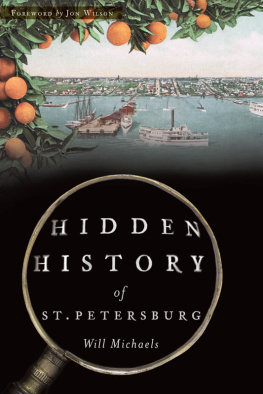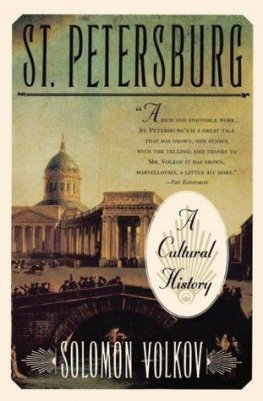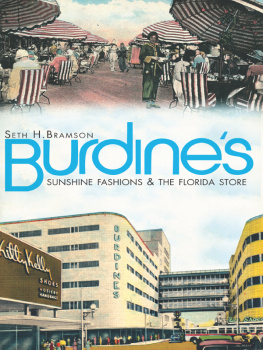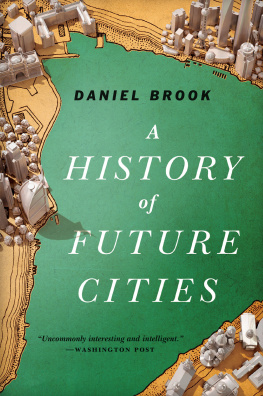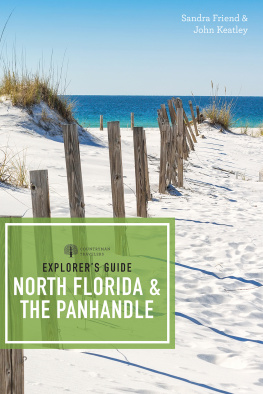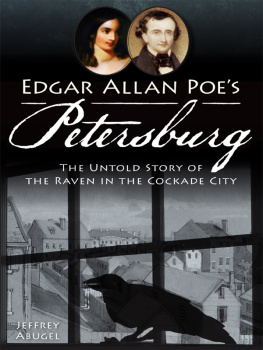


Original town plat for St. Petersburg, dated 1888 and filed by Peter Demens. 6th Avenue later became Central Avenue. Reservoir Lake became Mirror Lake. Williams Park is shown as Park. Courtesy St. Petersburg Museum of History.

Published by The History Press
Charleston, SC
www.historypress.net
Copyright 2016 by Will Michaels
All rights reserved
Cover image by Foley & Fisher Real Estate and Fire Insurance, Detroit Publishing Company; courtesy of Michaels Family Collection.
First published 2016
e-book edition 2016
ISBN 978.1.62585.820.7
Library of Congress Control Number: 2016932071
print edition ISBN 978.1.46713.541.2
Notice: The information in this book is true and complete to the best of our knowledge. It is offered without guarantee on the part of the author or The History Press. The author and The History Press disclaim all liability in connection with the use of this book.
All rights reserved. No part of this book may be reproduced or transmitted in any form whatsoever without prior written permission from the publisher except in the case of brief quotations embodied in critical articles and reviews.
Dedicated to St. Petersburgs family of historians, including:
John A. Bethell (1914)
Karl H. Grismer (1924)
William L. Straub (1929)
Walter P. Fuller (1973)
Gay Blair White and Warren Brown (1984)
Rita Slaght Gould (1987)
Albert Parry (1987)
Raymond Arsenault (1988)
Thomas Reilly (1997)
Bruce R. Stevenson (1997)
Rick Baker (2000)
Scott Taylor Hartzell (2002)
Sandra W. Rooks (2003)
Gary R. Mormino (2005)
John Wilson and Rosalie Peck (2006)
Judy Lowe Wells (2006)
Nevin D. Sitler and Richard N. Sitler (2013)
and others
Dates denote first published work.
CONTENTS
F OREWORD
People who love St. Petersburg will love its Hidden History. Author Will Michaels, a meticulous historian, offers a journey through a wonderland of Sunshine City stories, familiar but painted with rare affection and detail. For example, many know about early philanthropist Edwin Tomlinson, whose name remains associated with several St. Petersburg landmarks. But who knew that the (arguably) eccentric entrepreneur built a two-hundred-foot wooden tower at his house? And why? Far be it from this foreword to provide spoilers. Hidden History of St. Petersburg will tell all.
Mining the lore and legendand sorting out the useful gemsmarks the books feature characteristic. Al Capone in town back in the Roaring Twenties? This lovely and lively rumor has been around for decades, and Michaels sets us straight. The first shopping center? It was not Central Plaza. In fact, there were two that predate the sprawling mid-twentieth-century retail center. Their locations may surprise you. The storied Manhattan Casino on segregated St. Petersburgs main African American thoroughfare? James Brown, the Godfather of Soul, played there; Michaels tells the story of the local musician whom Brown adopted.
A powerful note begins the book. Among St. Petersburgs more secluded secrets are remains of the Tocobaga Indian settlements that thrived here long before 1492, and Michaels points out the tribes mounds and what they tell us about the ancient native civilization. After the opening chapter, Michaels employs some of each eras luminaries (and characters) to help guide us virtually to the present. Along the way, he sketches the dynamics and the personalities behind the remarkable revival downtown that took place starting in the 1990s and continues now. It is among the first written descriptions of what will certainly be viewed by later historians as a pivotal time in the St. Petersburg story. For political buffs, there is a detailed chapter about St. Petersburgs voting profile in presidential elections from 1952 through 1984. And the rationing, meatless Tuesdays and lookouts positioned atop the Vinoy recall the tense times of World War II.
On the lighter side, Michaels takes up the question of Babe Ruths longest home run and includes a rare and extensive interview he conducted with the Bambinos daughter. He recounts the accomplishments of the society ladies whose Womans Town Improvement Association brought St. Petersburg many of its early improvementsover the harrumphing of some St. Petersburg men who considered the doughty Victorians to be meddlers. The WTIA, by the way, held its first meeting in the venerable Detroit Hotel, where musical legend Jim Morrison played a gig or two during his early days here.
Local personalities and names somehow familiar do bring Hidden History of St. Petersburg a sweet local flavor. Figures such as retail genius James Earl Doc Webb and waterfront visionary William L. Straub of course get their due. So does St. Petersburgs history community, either in the text or in the rich notes at the end of each chapter. Readers will recognize such names as Ray Arsenault, Gary Mormino, former mayor Rick Baker and the late Scott Hartzell, along with earlier chroniclers like John Bethell, Karl Grismer and Walter Fuller. Their works are referenced often. Other folks pop up like faces at family reunions. Theres Jeff Moshier, who became the Evening Independent sports editor right out of high school; Reverend James L. Duncan, missionary rector at St. Peters Cathedral; aviation historians Warren Brown and Tom Reilly; Dr. Ralph Wimbish, the civil rights activist who died young; dramatist Bill Leavengood and composer Lee Ahlin, who collaborated to produce Webbs City: The Musical; Beach Drive developers Jack Bowman and Mike Cheezem; Marty and Elaine Normile, long associated with downtown and the Vinoy Resort; lifelong residents Nancy Osmon Haak and Betsy Pheil; and more and more.
Read every word. You will have embraced St. Petersburg as never before.
JON WILSON
Florida Humanities Council
Jon Wilson is a lifelong journalist serving as a reporter and editor for the Evening Independent and St. Petersburg Times (now the Tampa Bay Times). He is co-author with Rosalie Peck of St. Petersburgs Historic 22nd Street South and St. Petersburgs Historic African American Neighborhoods and author of The Golden Era in St. Petersburg: Postwar Prosperity in the Sunshine City. He is also the author of the Cracker Western novel Bridgers Run. Jon is currently a communications consultant with the Florida Humanities Council.
PREFACE
History does not refer merely to the past. On the contrary, the great force of history comes from the fact that we carry it within us, are unconsciously controlled by it in many ways, and history is literally present in all that we do.
James S. Baldwin
Like my first book, The Making of St. Petersburg, this work is a selection of articles originally published by the St. Petersburg Northeast Journal. The articles have been updated to reflect more recent information. The Journal is a small but worthy publication primarily distributed in the northeast area of St. Petersburg. I have been writing a history column for the
Next page
